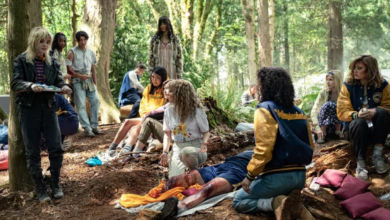YELLOWJACKETS: THE UNKNOWN THROUGH LOTTIE AND THE USE OF STATIC

Yellowjackets has everything: cannibalism, queer relationships/homoerotic friendships, and supernatural elements wrapped up in a bloody and unflinching depiction of adolescence and trauma. Like most horrors, the terror and mystery of Yellowjackets is tied to a broader question of the unknown—feelings, actions, events that cannot be explained through logic and rationale. Caution, light spoilers ahead.
The show splits and glides between 1996 when its titular high school soccer team initially becomes stranded in the forest and 2021 when a certain number of the now-grown characters reunite. In this show, the fear comes from the unknown of surviving and healing. These topics are interestingly grounded and further explored in the latest season when introducing the adult character of Lottie.
Season 1 largely centers on the team’s first summer in the wilderness intermixed with their adult selves dealing with the trauma of their past. So while the teens are shown learning how to hunt, creating new rules and roles for their community, and preparing for winter, the adults struggle with incessant questions about their time in the wilderness and their ability to heal. Yellowjackets does not shy away from depicting its characters as flawed and contradictory, yet I will admit that I was worried about the implications of the season finale when it alluded to a villain arc for Charlotte “Lottie” Matthews, a character played by two actresses of part Māori descent (Courtney Eaton and Simone Kessell).

We see Lottie as someone who is slowly starting to have visions in the wilderness that seem to predict the future. So some of the girls begin to think of her as a leader, much to the annoyance of other characters who would much prefer to be the Queen B of the Yellowjackets hive. As the audience, we know that Lottie has Schizophrenia because of two shots of her pills in the pilot episode.
While the first season did not provide much development or insight into Lottie’s background and relationships, the second season opens up with more details about her diagnosis, especially in the way her father frames her as broken and needing to be “fixed.”
On Twitter and TikTok, I have seen many users questioning and criticizing Lottie for not disclosing her mental illness to the rest of the group. Additionally, the parallels between the two timelines, in which teen Lottie rises to great influence among the rest of the Yellowjackets and adult Lottie runs a wellness center, connects her to the image of a cult leader. Both these processes of audience interpretation and textual depiction ignore the stigma surrounding mental illness and the harm of uncritically representing mental illness as supernatural, villainous, and suspicious.
Even though I do not think Lottie should be construed as solely manipulative and spiteful, I am also not advocating for Lottie to be seen as a victim since this further dehumanizes her and removes her agency. Rather I choose to see Lottie as a complicated character in the static.
Yellowjacket’s iconic opening title sequence uses TV static breaks when shifting between images of the teenagers and their adult selves over a grunge-inspired theme song. The static reminds me of times when a tornado or heavy thunderstorm would mess with the TV signal, leaving grainy and colorless streams on the box set. That static was a divide and break yet a promise that the images would come back. In the second season, these static images are further integrated into the narrative as more of the characters in the wilderness—starved and increasingly suspicious of each other—become detached from their physical reality.
Interestingly, these static breaks are also used during a pivotal scene in season 2, episode 7. At this point in the show, all of the adult characters are finally together. There is a lot of tension between the women since they are unsure about Lottie’s intentions because again, a lot of them see her as a manipulative cult leader.
The women are also afraid of their futures, and in many ways, they are running to Lottie to escape their troubles. They gather in a reunion celebration despite their apprehension because, at the heart of it all, they are the only ones who can even begin to understand what each other went through. They dance around a fire, but the static enters this scene to introduce a moment from the earlier plotline beating Lottie up severely. Teen Lottie encourages this character to let her anger out, offering up her body as a vessel. Lottie knows that some of the girls have seen her as a leader and therefore a source of blame for the more violent actions they participated in.

Lottie’s care and kindness are often overshadowed by her ominous narrative, but in the static that splits and joins these scenes of camaraderie and brutality, Lottie wishes and aspires for a healing dependent on each other. Lottie is often critical of the influence she seems to wield with her words as her adult self attempts to understand her mental illness and upbringing. She knows it is harmful when she is revered at an extreme level. Therefore, the static opens up two scenarios in which Lottie is no longer a cold and calculated villain. She is just a young girl in 1996 who wants to help her friend, even if here she is performing the role of women of color as caretakers for the white characters.
In 2021, she is a traumatized woman surrounded by people she cares about, all of whom are suffering in various ways. This static breaks the reality of Lottie being the big bad of the season, bringing together the idea that these characters need each other. Even if it’s unconventional or taboo, they are connected in their journeys of survival and healing.
While it is easy to blame and fear that which is unfamiliar, especially when it is connected to mental illnesses and other forms of disability, Lottie’s character offers insight into an unknown containing different visions of how people can survive, heal, and live. I hope to watch more of Lottie’s journey in future seasons of Yellowjackets (strike permitting) in which she continues to be a pivotal point in the breakage of reality in the show while exploring the need for community care and strength.



